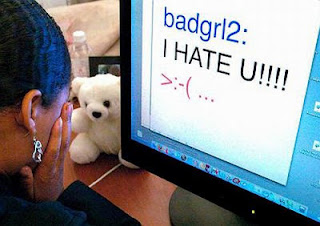Teaching Cybersafety: Who's Job?
Should Teachers or Parents Monitor Cyber safety?
I believe schools can take a proactive stance on cyber safety by offering PD to staff members so students are not given tech advice only by ICT personnel that they may see for only one period every other day. For teachers using a variety of web 2.0 tools, things can go from playful to pretty mean, pretty quick.
 |
| Image Courtesy of CC |
One study from Patricia Snell suggests that cyber bullying (especially for girls) may be a sadistically social activity and the process of ganging up on someone may be a way to build comradarie amongst a small clique of friends. A good discussion point we had last night about this is that conflict is drama and drama is entertaining. When students see a negative conversation with sparks flying, they are drawn to it like fireworks on the fourth of July. Some people would rather watch an accident happen than rush in to help. Do 11 year olds have the maturity to step in as mediators, or will they take the side of their friend which allows them the most upward social mobility?
We'd like think of adults being more mature than this, but this is not true either. Every day we are bombarded with our choice of opinionated mud-slinging from talking heads from one side of the aisle to the other and instead of intervening with "Dear Jon- You should be more thoughtful of what you said to Rush.", we take a side, plant a sign with our opinion and declare ourselves either with us or them. Opinions, propaganda and rumor mills are profligated by talk shows, news media and is a multimillion dollar industry.
 |
| Ann Coulter has made a living from negative comments. Image courtesy of CC |
How should be having Conversations about Cyber safety with students?
Our advisory program (pastoral) has had some good resources and lessons about cyber safety and cyber bullying. What I have found most interesting through these discussion (and perhaps disheartening) is that students do and say things online and don't think what they're actually doing is bullying. One case is of friends who logged on to a friends account when she was away at the computer and sent a message to a potential suitor her and negating her chances. Another interesting one is "Sarah's Secret" who learned that some classmates made a website with embarrassing pictures of her and she didn't inform anyone. Not even her parents.
 |
| Image courtesy of CC |
It seems like there are two approaches we can have: proactive and reactive. Although reactive conversations with school counselors and administrators will never go away, I think the rise of the networked educator will have a great propensity to discuss and in a proactive way.
"Teachers that develop their own professional learning network join the ranks of technology resource facilitators by modelling appropriate use, digital ettiqutte and privacy settings"
I have felt this especially in the last three years as I've expanded my digital footprint. Where before, I would need a ICT professional to address such matters, I now find myself a little more experienced with such matters: at least enough to give the students case studies, think pieces and advice to make good choices.
Trying to build a school culture where cyberbullying is non-existant is like thinking a city can be 100% crime free- it can't happen. But we can build a healthy community, build respect and keep the chatter to a minimum.
Related Posts
Managing your digital footprint as an educator
Why should we connect students?

Comments
Post a Comment